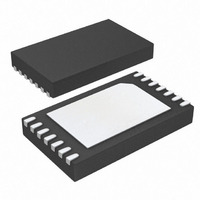DS2784G+ Maxim Integrated Products, DS2784G+ Datasheet - Page 24

DS2784G+
Manufacturer Part Number
DS2784G+
Description
IC FUEL GAUGE STND-ALONE 14-TDFN
Manufacturer
Maxim Integrated Products
Datasheet
1.DS2784G.pdf
(43 pages)
Specifications of DS2784G+
Function
Fuel, Gas Gauge/Monitor
Battery Type
Lithium-Ion (Li-Ion), Lithium-Polymer (Li-Pol)
Voltage - Supply
2.5 V ~ 4.6 V
Operating Temperature
-40°C ~ 85°C
Mounting Type
Surface Mount
Package / Case
14-TDFN
Product
Fuel Gauges
Operating Supply Voltage
2.5 V to 4.6 V
Supply Current
85 uA
Maximum Operating Temperature
+ 85 C
Minimum Operating Temperature
- 40 C
Charge Safety Timers
Yes
Mounting Style
SMD/SMT
Temperature Monitoring
Yes
Uvlo Start Threshold
2.4 V
Uvlo Stop Threshold
2.5 V
Lead Free Status / RoHS Status
Lead free / RoHS Compliant
DS2784: 1-Cell Stand-Alone Fuel Gauge IC with Li+ Protector and SHA-1 Authentication
the charge current at the end of the charge cycle to ensure reliable charge termination detection. IMIN is located in
the parameter EEPROM block.
Active Empty Voltage (VAE)—VAE stores the voltage threshold used to detect the active empty point. The value
is stored in 1-byte with units of 19.5mV and can range from 0V to 4.978V. VAE is located in the parameter
EEPROM block. See the Modeling Cell Characteristics section for more information.
Active Empty Current (IAE)—IAE stores the discharge current threshold used to detect the active empty point.
The unsigned value represents the magnitude of the discharge current and is stored in 1-byte with units of 200V
and can range from 0 to 51.2mV. Assuming R
= 20m, IAE can be programmed from 0mA to 2550mA in 10mA
SNS
steps. IAE is located in the Parameter EEPROM block. See the Cell Model Construction section for more
information.
Aging Capacity (AC)—AC stores the rated cell capacity, which is used to estimate the decrease in battery
capacity that occurs during normal use. The value is stored in 2 bytes in the same units as the ACR (6.25Vh).
When set to the manufacturer’s rated cell capacity the aging estimation rate is approximately 2.4% per 100 cycles
of equivalent full capacity discharges. Partial discharge cycles are added to form equivalent full capacity
discharges. The default aging estimation results in 88% capacity after 500 equivalent cycles. The aging estimation
rate can be adjusted by setting the AC to a value other than the cell manufacturer’s rating. Setting AC to a lower
value, accelerates the aging estimation rate. Setting AC to a higher value, retards the aging estimation rate. The
AC is located in the parameter EEPROM block.
Age Scalar (AS)—AS adjusts the cell capacity estimation results downward to compensate for aging. The AS is a
-7
). A value of 100%
1-byte value that has a range of 49.2% to 100%. The LSb is weighted at 0.78% (precisely 2
(128 decimal or 80h) represents an unaged battery. A value of 95% is recommended as the starting AS value at the
time of pack manufacture to allow the learning of a larger capacity on batteries that have an initial capacity greater
than the rated cell capacity programmed in the cell characteristic table. The AS is modified by aging estimation
introduced under aging capacity and by the capacity-learn function. The host system has read and write access to
the AS, however caution should exercised when writing it to ensure that the cumulative aging estimate is not
overwritten with an incorrect value. The AS is automatically saved to EEPROM (see Table 7 for details). The
EEPROM value is recalled on power-up.
Full capacity estimation based on the learn function is more accurate than the cycle-count-based estimation. The
learn function reflects the current performance of the cell. Cycle count based estimation is an approximation
derived from the manufacturer’s recommendation for a typical cell. Batteries are typically considered worn-out when
the full capacity reaches 80% of the rated capacity, therefore, the AS value is not required to range to 0%. It is
clamped to 50% (64d or 40h). If a value of 50% is read from the AS, the host should prompt the user to initiate a
learning cycle.
CAPACITY ESTIMATION OPERATION
Aging Estimation
As discussed above, the AS register value is adjusted occasionally based on cumulative discharge. As the ACR
register decrements during each discharge cycle, an internal counter is incremented until equal to 32 times the AC.
The AS is then decremented by one, resulting in a decrease of the scaled full battery capacity by 0.78%
(approximately 2.4% per 100 cycles). See the AC register description above for recommendations on customizing
the age-estimation rate.
Learn Function
Since Li+ cells exhibit charge efficiencies near unity, the charge delivered to a Li+ cell from a known empty point to
a known full point is a dependable measure of the cell capacity. A continuous charge from empty to full results in a
learn cycle. First, the active empty point must be detected. The learn flag (LEARNF) is set at this point. Then, once
charging starts, the charge must continue uninterrupted until the battery is charged to full. Upon detecting full,
LEARNF is cleared, the charge to full (CHGTF) flag is set, and the age scalar (AS) is adjusted according to the
learned capacity of the cell.
24 of 43











